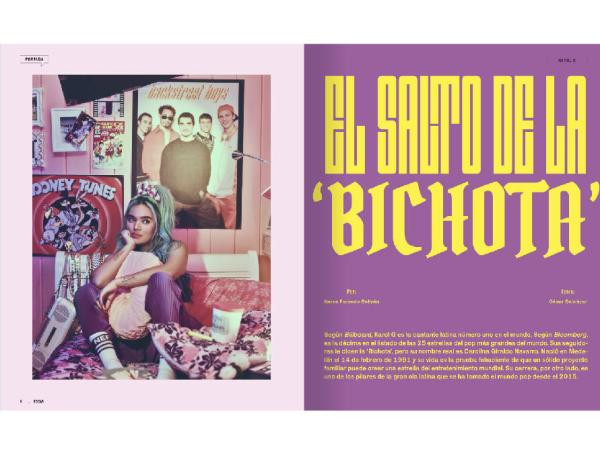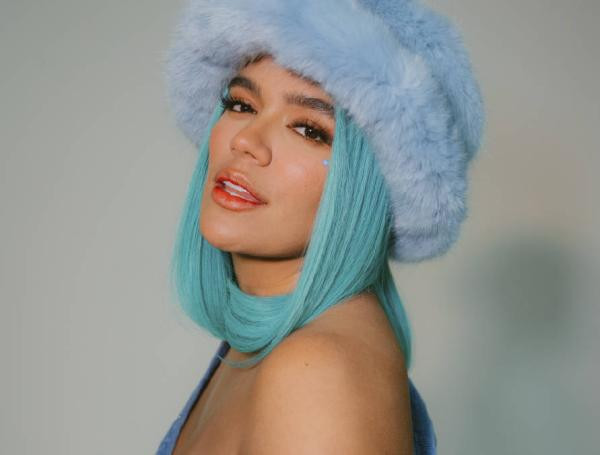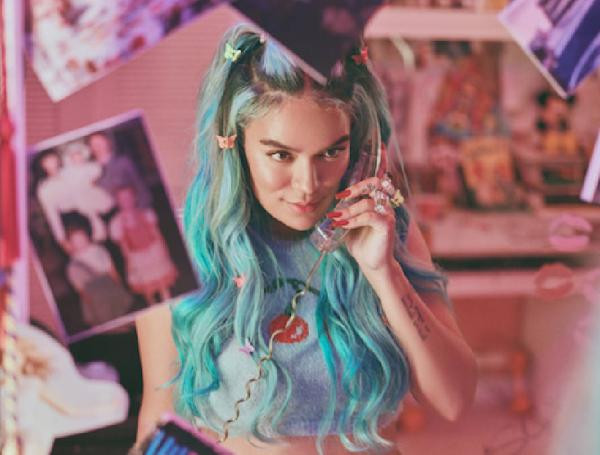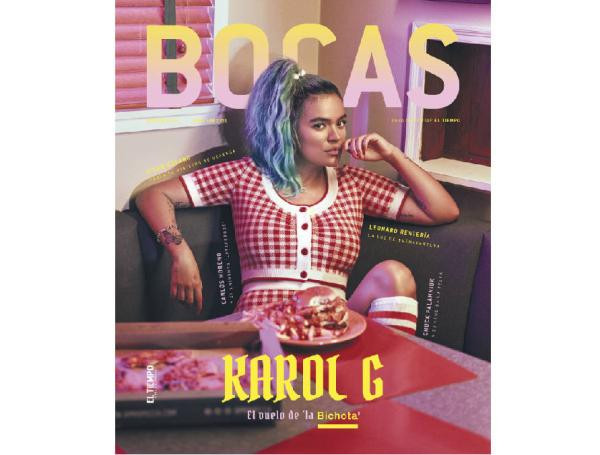Karol G has become a global phenomenon in the music industry, captivating audiences worldwide with her vibrant personality and chart-topping hits. But to truly understand Karol G’s journey and artistry, it’s essential to know where she comes from. This exploration delves into the Colombian roots of Karol G, tracing her upbringing, family influences, and the city that shaped the woman behind the music.
Carolina Giraldo Navarro, globally known as Karol G, was born on February 14, 1991. Her birthplace and childhood home was Medellín, Colombia. This bustling city, nestled in the Aburrá Valley, is not just her place of origin; it’s deeply woven into the fabric of her identity and career. Medellín, known for its rich culture, vibrant music scene, and resilient spirit, has undeniably played a significant role in shaping Karol G into the artist she is today.
Karol G’s career was far from an overnight success; it was a meticulously nurtured family endeavor from its inception. The Giraldo Navarro family rallied around Carolina’s burgeoning talent, transforming her early passion into a focused project. Even as a child, her captivating voice and innate love for performing were evident in any family gathering that involved music. Born into a comfortable middle-class household as the youngest of three daughters, Karol G’s potential was recognized and fostered from a young age.
 Apertura de la entrevista de Karol G en la edición impresa de Revista Bocas. Edición 104, de marzo – abril de 2021.
Apertura de la entrevista de Karol G en la edición impresa de Revista Bocas. Edición 104, de marzo – abril de 2021.
Karol G’s Revista Bocas Interview – Cover of the magazine showcasing the Colombian singer in an in-depth interview about her life and career beginnings in Medellín.
Her father, Guillermo Giraldo, affectionately known as “Papa G,” became the driving force behind her early career. A self-taught musician, Guillermo recognized his daughter’s potential and took on the roles of promoter, manager, and coach. From the tender age of five, he guided her performances at local fairs and even enrolled her in a children’s reality show. He was instrumental in securing her first recording contract at the age of 14 and facilitated her initial exposure to the music industry in the United States in 2009. Although this early US venture presented challenges, with Karol G being asked to focus on songwriting rather than her own stardom, her father’s unwavering belief in her talent never faltered.
Guillermo’s steadfast commitment to Karol G’s career was deeply rooted in his “paisa” spirit – a term referring to people from the Andean region of Colombia, known for their resilience and determination. This unwavering support led to the creation of the Karol G persona we know today, with “Papa G” remaining a constant and influential figure in her professional life.
Karol G describes her rise to stardom as taking “the slow route,” a journey of perseverance and patience that both she and her father understood. This understanding was palpable during a heartwarming moment in 2018 on the show “Don Francisco Te Invita.” The veteran host introduced Guillermo as “He is the father of Karol G!” as he joined his then 27-year-old daughter, already a successful artist with her debut album “Unstoppable” (2017), on stage. This public acknowledgment highlighted the integral role Papa G played in her ascent.
Earlier that year, in January 2018, Karol G’s dedication and hard work culminated in winning the Latin Grammy for Best New Artist. In a moving tribute, she brought her father on stage to share the momentous occasion. “I want to share this with this man here, who is 99 percent of the success of my career: my dad!” she declared, underscoring his immense contribution. Guillermo, filled with pride, added, “To the Academy, to the Latin Grammys, and to everyone in the industry: thank you for believing in our project and God bless you.”
By 2018, Karol G had solidified her position in the music industry, signing with Universal Music, the same label home to urban music giants like J Balvin, Daddy Yankee, and Don Omar. This milestone followed years of relentless pursuit, marking her as the pioneering woman who broke through as a solo artist in the new wave of reggaeton. Notably, she achieved this while fearlessly embracing openly sexualized lyrics, mirroring the themes prevalent among her male counterparts in the genre.
Karol G’s global impact continued to escalate, reaching new heights as she was recognized as the #1 Latina artist in the world for two consecutive years (2019 and 2020) by Billboard. She also became the most viewed female singer on YouTube and a top-listened artist on Spotify, boasting 33 million monthly listeners and over 2.2 billion streams by the end of 2020. Her mega-hits ‘Bichota’ and ‘Ay, Dios mio’ achieved 5 and 6 platinum certifications respectively, becoming ubiquitous anthems throughout Colombia, echoing as ringtones and sung by children in every neighborhood of Medellín.
In 2020, amidst the global pandemic, Karol G reached a pinnacle with her collaboration with Nicki Minaj, ‘Tusa’. The song debuted at #1 on Billboard’s Hot Latin Songs chart and became the most streamed Latin song of the year, solidifying her status as a global music icon. The same year, Karol G graced the Latin Grammy gala in a memorable pink Dolce & Gabbana dress emblazoned with the slogan: “Un hombre le pagó mal, ya no se le ve sentimental” (A man paid her badly, she is no longer sentimental). Her performance that night, featuring an all-female band in a Mount Olympus-inspired setting, cemented ‘Tusa’ as the year’s anthem, with Karol G embodying the mythological ‘Bichota’ figure on stage.
 En 2018, la colombiana ganó el Grammy Latino a mejor nuevo artistas. Y en 2020, su canción Tusa, que hace parte de su nuevo álbum KG0516 (2021), debutó como #1 en el listado Hot Latin Song de Billboard.
En 2018, la colombiana ganó el Grammy Latino a mejor nuevo artistas. Y en 2020, su canción Tusa, que hace parte de su nuevo álbum KG0516 (2021), debutó como #1 en el listado Hot Latin Song de Billboard.
Karol G Latin Grammy Award 2018 – Image of Karol G celebrating her Latin Grammy win for Best New Artist in 2018, a significant milestone in her career originating from Medellín, Colombia.
Reflecting on her journey, Karol G recalls envisioning her current success years ago. “Someday there will be a whole audience going to a place for me,” she remembers thinking during her early days as a backup singer for Colombian reggaeton artist Reykon. This early experience provided invaluable insight and fueled her ambition.
Turning 30 in 2021, Karol G’s signature blue hair is a nostalgic nod to her school days at Calasanz, a religious all-girls school in Medellín. Interestingly, her initial foray into the digital world was through a YouTube channel called CaritoGCol, launched in 2010, where she shared early musical content. A tattoo on her forearm featuring Rihanna, Selena Quintanilla, and herself visually represents her musical inspirations and self-affirmation.
Her 2019 album, “Ocean,” showcased collaborations with a diverse range of artists including Damian Marley, Anuel AA, Yandel, Maluma, J Balvin, and Nicky Jam. “Culpables,” a standout track from this album, marked the beginning of her relationship with Puerto Rican artist Anuel AA, although their engagement in 2020 reportedly concluded later.
Despite her success, Karol G has openly spoken about the challenges and darker aspects of the industry. “I had very indecent proposals along the way, from people for whom you become a product. It was a very painful situation,” she revealed, highlighting the obstacles she overcame while maintaining her integrity.
Karol G’s career trajectory continues upwards, mirroring the global ascent of Latin urban music since 2015. Bloomberg recognized her rising prominence, ranking her at number 10 on its Pop Star Power Rankings in early February. This list evaluates the world’s top 25 pop stars monthly and, notably, included a significant representation of Latin artists, with five Puerto Ricans and four Colombians, including Bad Bunny at the top.
Currently, Karol G is preparing for the release of her highly anticipated third studio album, “KG0516.” The enigmatic title, representing May 16, 2005 – the date she legally adopted the stage name Karol G – hints at a deeply personal project. The album cover, designed by David Lachapelle, and a seven-minute reggaeton tribute featuring genre pioneers, as well as collaborations with Ludacris and a TikTok influencer, promise a diverse and groundbreaking musical experience. “I’m going to pass away [laughs]. If this album doesn’t come out, I’m not going to last,” she jokes, with the characteristic playful smirk seen in her music videos, expressing her excitement and anticipation for this new chapter in her career.
Reflecting on her early influences, Karol G fondly recalls her upbringing in Medellín. When asked about a 1996 video of her singing “Eva María se fue buscando el sol de la playa” accompanied by her father on the vallenata box, she acknowledges the early seeds of her musical journey. “In my family it was super crazy because from day one they believed that everything was possible, especially my closest family: my parents and my sisters. Since I started saying that I wanted to be a singer, they were always there,” she explains. “I think that video was from my first “concerts”. It is amazing to have photos and videos of those moments because today I can see how far we have come and remember that since I was little I wanted to be here.”
Her musical landscape was diverse, encompassing boleros, popular music, and even English-language artists introduced by her father. “My dad always wanted to be a singer,” she shares. “He had a music group with which he played at village parties; it was his hobby. Several times he took me to sing Pimpinela songs with him. The first artists I listed to were Pimpinela, Sandro, Tormenta, also a lot of vallenato. Thalía was an artist that I fell in love with hard when I heard her for the first time, and she was so young. But my dad also listened to a lot of music in English: The Bee Gees, Metallica. I was very romantic in my early years. My style was similar to those ballads that I heard when I was little.”
Interestingly, before fully embracing music, Karol G harbored aspirations of becoming a professional motocross rider. “I had a dream of becoming a professional motorcycle rider,” she reveals. “I have two cousins who have done motocross for many years, and they have won several awards. But there was no way my parents would let me follow that path. One of my cousins had a very bad accident and from that moment on it was forbidden to ride a motorcycle in my house.” While motocross remained a passion, her musical talent ultimately took precedence.
 Karol G fue a un colegio religioso y tuvo una crianza conservadora. En Medellín, durante su adolescencia, conoció el reguetón y desde ese momento supo que sería el género musical de su carrera.
Karol G fue a un colegio religioso y tuvo una crianza conservadora. En Medellín, durante su adolescencia, conoció el reguetón y desde ese momento supo que sería el género musical de su carrera.
Karol G Medellín School Days – A picture of Karol G during her school years in Medellín, highlighting her conservative upbringing in the city that shaped her musical journey.
Despite attending a religious school and describing herself as a very introverted girl in her youth, Karol G found her niche in music class. “At school I was a very introverted girl. I was very shy and did not have that much self-esteem or many relationships with people, but I was the best one in music class,” she recalls. “At least there was a class where I didn’t have to do things alone, nor wait to see who was left to work with. In music class there was always someone who wanted to be with me. It was my moment of glory.”
Reflecting on her all-girls, religious education in Medellín, Karol G notes its influence on her upbringing. “Actually, I was recently talking to someone on my team that you are raised by codes. Some people manage to let them go and develop their personality more, but there are others in which those codes remain for life. In my house we were a traditional Colombian family that went to mass every Sunday and on Saturdays we visited my grandmother, so I never had a problem with my school’s education.” However, she acknowledges a rebellious phase in her later school years. “Maybe, in 10th and 11th grades, I have to say that I was a very rebellious girl,” she admits, describing experimenting with piercings and hair dye as expressions of her teenage rebellion.
Growing up in the Medellín neighborhoods of La Mota and El Velódromo, Karol G describes a relatively quiet adolescence. “I was the typical 15-year-old girl who went to parties and left early. I would arrive at nine at night and at twelve they would pick me up. Literally, I would eat and leave. The only full fifteen-year-old party I ever got was mine,” she recounts, highlighting her focused nature even during her teenage years. Her 15th birthday party, Tinkerbell-themed and limited to 28 friends, further illustrates her grounded personality.
It was during this time that Karol G discovered reggaeton, a genre that would define her career. “The first urban sounds that I heard, more than those of Puerto Rico, were those of Los cuentos de la cripta, who were from Panama. Cuentos de la Cripta were everything! I also listened to La Factoría and from there I began to listen to the first reggaeton songs, such as La gasolina,” she explains. “I really liked ‘Latigazo’, by Daddy Yankee, and Dembow, by Wisin y Yandel. It was love at first sight. I have loved reggaeton since I heard it the first time. Actually, I didn’t end up singing this genre because it touched me or to fit in, or to sing what was happening. The moment I called myself Karol G, I knew that my music was going to be reggaeton, urban music.”
At the age of fourteen, Karol G auditioned for the ‘XS Factor,’ a pivotal experience in her early career. While she didn’t progress to the televised stages, the experience proved to be a valuable learning opportunity. “The disappointment was huge for my parents. They blamed each other a lot. They said that maybe I didn’t wear the right clothes, that maybe I didn’t choose the right song. It was a very nice learning moment. After that, I came back to Medellin determined to be more outgoing.”
Simultaneously, Karol G honed her musical skills at the music children group at the University of Antioquia in Medellín for five years. This rigorous training provided her with a comprehensive understanding of music theory and history. “It was a very brutal process because it was understanding music not only as a hobby. I began to see greatness, profession, and art. I studied the history of music and the reading of musical notes. Thanks to that knowledge I can sit down today to produce one of my songs,” she states, emphasizing the lasting impact of her formal music education in Medellín. She later pursued undergraduate music studies at the same university, further solidifying her foundation. However, her burgeoning career took a different path when she became a backup singer for Reykon, a decision that provided real-world industry experience.
 La cantante colombiana es la portada de Revista BOCAS en su edición 104, de marzo de 2021.
La cantante colombiana es la portada de Revista BOCAS en su edición 104, de marzo de 2021.
Karol G Revista Bocas Cover – Another view of Karol G on the cover of Revista Bocas, representing her Colombian identity and the magazine’s feature on the Medellín-born artist.
Before her breakthrough as a solo artist, Karol G explored various avenues within the music industry, including voiceover work for commercials. Her vocal coach recognized her talent for voice acting, leading to opportunities to voice Spanish-language commercials for major brands like Play-Doh, Hasbro, and Barbie. This diverse experience showcases her versatility and determination to succeed in the entertainment world.
Karol G and her father consciously chose a “slow road” approach to her career, prioritizing dignity and integrity over shortcuts. This decision was prompted by uncomfortable and “indecent proposals” early in her career. “I used to say to him: ‘Daddy, that person is suggesting weird things that make me feel uncomfortable and I think we should run’,” she recounts. Instead of compromising her values, they opted for a gradual climb, building her career through school concerts, radio shows, and local performances. Crucially, support from fellow Medellín artist J Balvin, who selflessly introduced her to industry figures, proved instrumental in her progression.
An anecdote highlighting the family’s proactive approach involves Karol G’s mother taking her demo CDs door-to-door to record labels in the United States. Despite initial rejections, this persistence eventually led to a formal offer from Universal Records seven years later, proving the long-term value of their dedicated efforts. Another example of their determination is the story of securing permission to sample Andrés Calamaro’s song “Mil Horas,” showcasing their resourcefulness and Papa G’s unwavering commitment to making things happen.
Karol G’s official signing with Universal Music in 2016 marked a turning point in her international career. Initially managing her career independently with her father, she sought professional management to navigate this significant opportunity. The label’s interest was sparked by an internal study identifying Karol G as an artist with strong international potential, validating her and her father’s long-held belief in her global appeal.
As the first woman in reggaeton to collaborate with leading male artists like Nicky Jam, Ozuna, J Balvin, and Bad Bunny, Karol G broke significant barriers in a male-dominated genre. These collaborations provided her with invaluable exposure and credibility, accelerating her rise to prominence. “I felt like their darling girl because I had no other opportunities, neither on radio nor on television, to express myself, but they gave me that opportunity and that made my work evolve faster,” she acknowledges.
Her 2020 Grammy performance with an all-female band paid homage to pioneering women in music and highlighted the need for greater female representation in the industry. Inspired by artists like Patricia Tehran and the Diosas del Vallenato, Karol G actively champions female talent, ensuring her own team and projects provide opportunities for women in music. Her upcoming album features collaborations with female artists like Nathy Peluso, Mariah Angeliq, and Kali Uchis, further solidifying her commitment to empowering women in the industry.
In conclusion, Karol G’s journey to global superstardom is inextricably linked to her roots in Medellín, Colombia. From her upbringing in a supportive family to her early musical education and experiences in the city, Medellín has been the foundation upon which she built her extraordinary career. Her story is a testament to the power of perseverance, family support, and staying true to one’s origins while reaching for global recognition. Karol G’s music carries the vibrant spirit of Medellín to the world, making her not just a global superstar, but also a proud ambassador of her Colombian hometown.


